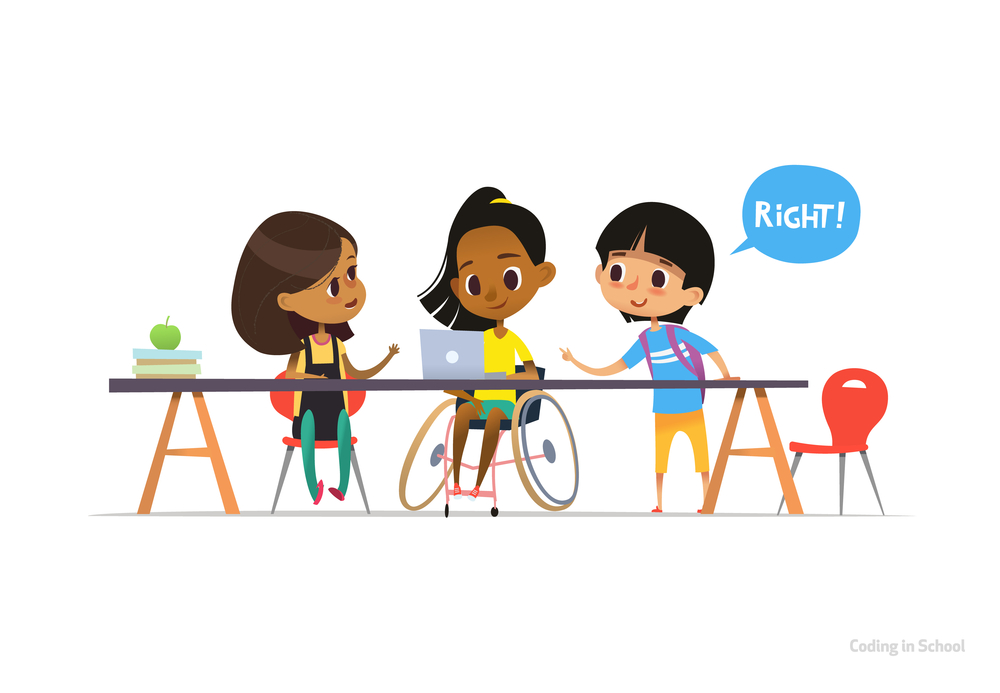
We Are Digital Citizens

Overview
Students will be learning what a digital citizen is and means in their setting and taking a more active role as digital citizens. Students will learn about the school's Acceptable Use Policy and work together to create a classroom contract on agreed upon acceptable behaviors.
This activity will take two class periods.
Learning Objectives
Students will:
- Be able to identify what a digital citizen is.
- Become familiar with the district Acceptable Use Policy.
- Be able to work in groups to build a classroom digital contract for positive citizenship.
Vocabulary
Vocabulary Words:
- Digital: Digital refers to any type of technology that you use.
- Citizen: This term means you belong to a group of people, like your classroom and your neighborhood.
- Digital Citizen: This refers to a group of people that use technology to communicate.
- Rules: There are rules about digital citizenship, and your school has a set called A. U. P.
- A.U.P.: This stands for Acceptable Use Policies or the rules for using technology appropriately in your school. Some examples are: taking care of the computer, not having drinks near them so they won't spill, not bullying someone online, and so forth.
Pre-planning
To prepare for this lesson:
- Check out the following teaching resources:
- Watch the video tutorial for the application you and your students will be using:
Accommodations
See the Accommodations Page and Charts on the 21things4students website in the Teacher Resources.
Steps
Directions for this activity:
1. Decide which videos to show the students from the pre-planning section.
Talk about what it means to be a good digital citizen.
- Sample answers are taken from Common Sense Media:
- Follow the rules on computers and electronic devices.
- Protect your and others’ private information.
- Communicate responsibly with each other.
- Respect the ideas and opinions of others.
- Stand up to cyberbullying.
- Give credit for other’s work.
2. Explain that part of being a good digital citizen is following your school district’s Acceptable Use Policy. Have students give what they think are good examples of rules for using computers or tablets at school. List them on the board, poster, or onscreen for reference and to add to later.
3. Show this cute video example of a policy from the Baltimore schools to see if there is something to be added to your class list.
4. Go over your school district A.U.P. in kid-friendly terms and add anything missed to your list.
5. As a class, break into small groups and assign them to come up with ways your class can be positive digital citizens.
6. Have the groups share their examples.
OPTIONS:
Use Popplet:
- Have each group develop a Popplet with a digital citizen in the middle of the Popplet and the characteristics surrounding it.
- As a class, use the Popplets to vote on five strong rules to be a good digital citizen in the classroom.
- Post these in your classroom for the year. You could also have students post the ideas to an online class web page such as Weebly or Schoology.
Assessment Options
Different options for assessing the students:
- Observations
- Check for understanding through discussion
- As a class, use the Popplets to vote on five strong rules to be a good digital citizen in the classroom.
- Have students present their FlipGrid at a parent night.
- Post these in your classroom for the year. You could also have students post the ideas to an online class web page such as Weebly or Schoology.
MITECS COMPETENCIES & ISTE STANDARDS
MITECS: Michigan adopted the "ISTE Standards for Students" called MITECS (Michigan Integrated Technology Competencies for Students) in 2018.
Digital Citizenship
2a. students cultivate and manage their digital identity and reputation and are aware of the permanence of their actions in the digital world.
2b. Students engage in positive, safe, legal and ethical behavior when using technology, including social interactions online or when using networked devices.
2c Students demonstrate an understanding of and respect for the rights and obligations of using and sharing intellectual property
Devices and Resources
All Devices: PC, Chromebook, Mac, iPad, cellphone
Websites:
Digital Citizenship | Things Explained
Digital Etiquette: Learn the Do's and Don't's of Online Communication
CONTENT AREA RESOURCES
ELA
-
Students write about what a digital citizen is in their own words with examples.
-
Students create a poem about a good digital citizen.
-
Students write a story about a boy or girl that breaks one of the rules with a moral.
Integrated Arts
-
Students draw what a digital citizen looks like.
-
Students create a poster of three-five examples of rules to post in the room.
Math
-
Students do research on how much time classmates spend online, what type of activity their are doing online.
-
Make a chart or graph of the results.
Social Studies
-
Students get data from their siblings, parents, grandparents, teachers, about their favorite web site, or thing to do online, or activity online.
-
Share and talk about the results of their survey.
Credits
This task card was created by Courtney Conley, Utica Community Schools, January 2018. Updated February 2025.


